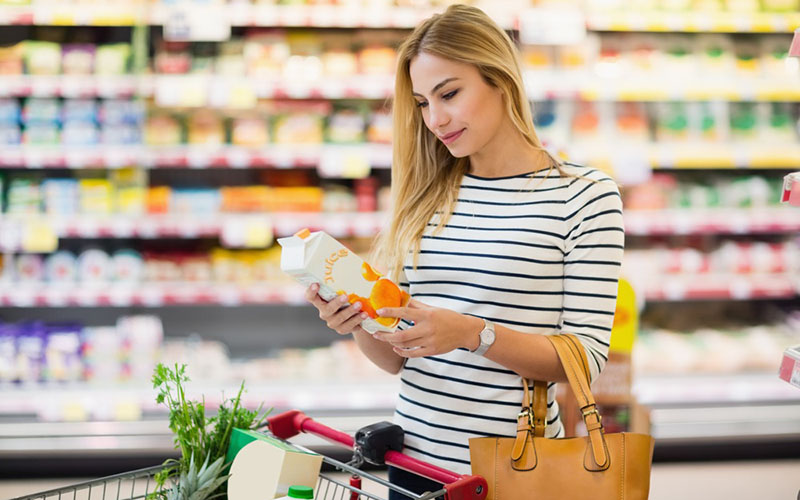It’s official. Millennials are the largest consumer block and they’re moving the retail environment forward in a more sustainable way. Shoppers are focused on their core values and want to buy from the brands that are in perfect alignment with them.
According to the National Retail Federation (NRF), around 60% of consumers would ditch the retail brands they love most if they realized the business’s values didn’t match their own. And social good and sustainability are high on the agenda for the new consumer majority. Shoppers are moving towards brands that are more socially conscious, like Starbucks. The coffee brand is eliminating plastic straws by the end of 2020.
So, it shouldn’t come as a shocker that more fresh retailers are increasing their green efforts. Shoppers want transparency and brands that are propelled by values and grocery retailers are no exception.
Here are 3 trends we’re seeing from grocery retailers:
1. Pushing back on plastics.

More grocery retailers are cutting back on plastics. Trader Joe’s is cutting a million pounds of plastic from stores – as soon as possible. The neighborhood grocery chain’s move was powered by a Greenpeace petition and 91,000 signatures. Trader Joe’s started moving away from plastics last year, announcing it will no longer distribute single-use plastic grocery bags and will be replacing Styrofoam packs and plastic produce bags with compostable alternatives that eliminate compounds like BPA.
In February Walmart announced a new set of waste reduction commitments for plastic packaging for its private brand program. The retailer expects the move to impact more than 30,000 SKUs to get the retailer right to the center of the industry’s plastic waste problem. Walmart’s focus on its private brand packaging, including efforts to minimize plastic waste for Walmart U.S. and Sam’s Club operations, comes in addition to the retail giant pushing other national brand suppliers to follow in suit.
2. Cutting back on carbon.

In addition to cutting back on waste, some grocers are looking to also slim down their carbon footprint. Both Martin’s Food Markets and Giant Food Stores are working on carbon-offset projects, including planting trees and starting local “greenscapes”. Starting this spring, for each gallon of gas customers pump at Giant and Martin’s fuel stations, the grocers will mobilize a volunteer network to generate these certified carbon-offset projects. Plans that could neutralize carbon emissions for the grocery chains by almost a third.
Walmart also recently announced plans to double the retailer’s electric vehicle charging sites, adding hundreds of stalls across 34 states. These additions will bring the retail giant’s number of charging units to over a thousand. As Earth Day rapidly approaches, this move comes in a bold attempt to reduce greenhouse gas emissions from Walmart’s value chain by a gigaton, (1 billion metric tons), by 2030. According to the retailer, Walmart’s suppliers have already reduced the carbon footprint by more than 20 million metric tons (MMT) of greenhouse gas emissions in the global value chain.
3. Reducing food waste.
 According to Loss Prevention Media, a third of food produced for human consumption is wasted, that number includes 10% of food on grocery store shelves. About 33% of all produce goes unused, representing 1.3 billion tons of food and almost $1 trillion annually. This shocking amount of waste has prompted more retailers to start selling “ugly” produce – fruits and vegetables that might not look perfect but are perfectly delicious and healthy. Kroger has started an ugly produce brand to change the way consumers think about their fruits and veggies.
According to Loss Prevention Media, a third of food produced for human consumption is wasted, that number includes 10% of food on grocery store shelves. About 33% of all produce goes unused, representing 1.3 billion tons of food and almost $1 trillion annually. This shocking amount of waste has prompted more retailers to start selling “ugly” produce – fruits and vegetables that might not look perfect but are perfectly delicious and healthy. Kroger has started an ugly produce brand to change the way consumers think about their fruits and veggies.
Grocers can also sell reusable storage containers extending product shelve lives and work with suppliers to create smaller produce sizes.
Technology is also making it possible for retailers to go greener with improved precision and visibility. More than half of retailers are investing in artificial intelligence solutions that can reduce waste by unlocking shopper data and other demand factors to provide much more accurate demand forecasting and drive the most efficient store replenishment. AI offers the automated ability to accurately predict customer demand at scale: down to the day, store and item level while incorporating hundreds of demand influencing factors like weather and pay-day effects.
Ready to go green? Start reducing waste with AI.
Looking to reduce harmful waste and maximize margins? Learn how JDA’s Luminate Store Fulfillment solution uses AI and machine learning (ML) to make sure you can meet demands and protect margins.

